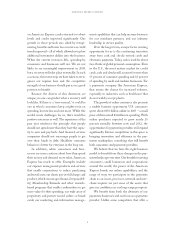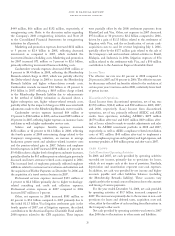American Express 2008 Annual Report Download - page 21
Download and view the complete annual report
Please find page 21 of the 2008 American Express annual report below. You can navigate through the pages in the report by either clicking on the pages listed below, or by using the keyword search tool below to find specific information within the annual report.
2008 financial review
american express company
fair value measurement (continued)
Description Assumptions/Approach Used Effect if Actual Results Differ
from Assumptions
Retained Subordinated Securities
See investment securities above for accounting
for the retained subordinated securities.
Interest-Only Strip
The interest-only strip is reported in other
assets on the Company’s Consolidated
Balance Sheets. Changes in the fair value of
the interest-only strip are also recorded in
securitization income, net in the Company’s
Consolidated Statements of Income.
Derivative Instruments
The Company’s primary derivative
instruments include interest rate swaps,
forward agreements, foreign currency
options and cross-currency swaps. Derivative
instruments are reported in other assets
and other liabilities on the Company’s
Consolidated Balance Sheets. Changes in
fair value are recorded in accumulated other
comprehensive (loss) income, and/or in
the Consolidated Statements of Income,
depending on (i) the documentation and
designation of the derivative instrument,
and (ii) if the derivative instrument is in
a hedging relationship, its effectiveness in
offsetting the changes in the designated risk
being hedged.
The discount rate for the retained
subordinated securities is estimated based
on an interest rate curve that is observable in
the marketplace plus an unobservable credit
spread commensurate with the risk of the
securities and similar financial instruments.
The fair value of the Company’s interest-
only strip is the present value of estimated
future positive excess spread expected to
be generated by the securitized loans over
the estimated remaining life of those loans.
Management utilizes certain estimates and
assumptions to determine the fair value of the
interest-only strip assets including estimates
for finance charge yield, credit losses, LIBOR
(which determines future certificate interest
costs), monthly payment rate and the
discount rate.
The Company’s retained subordinated
securities and interest-only strip are classified
in Level 3 of the fair value hierarchy.
See further in Note 6 to the Company’s
Consolidated Financial Statements.
Other-Than-Temporary Impairment
The Company reviews and evaluates its
investment securities, including retained
subordinated securities at least quarterly,
and more often as market conditions may
require, to identify investment securities that
have indications of other-than-temporary
impairments. The determination of other-
than-temporary impairment is a subjective
process, requiring the use of judgments and
assumptions. Accordingly, the Company
considers several metrics when evaluating
investment securities for an other-than-
temporary impairment, including the
extent to which amortized cost exceeds
fair value, the duration and size of that
difference, and the issuer’s credit rating. Key
factors considered when assessing other-
than-temporary impairment include the
determination of the extent to which the
difference is due to increased default risk for
the specific issuers, or market interest rate risk.
With respect to market interest rate risk,
including benchmark interest rates and credit
spreads, the Company’s intent and ability
to hold the investment securities for a time
sufficient to recover the unrealized losses is a
significant consideration in the other-than-
temporary evaluation process. See further
in Note 5 to the Company’s Consolidated
Financial Statements.
(continued on next page)
Other-Than-Temporary Impairment
In determining whether any of the
Company’s investment securities or retained
subordinated securities are other-than-
temporarily impaired, a change in facts
and circumstances could lead to a change
in management judgment around the
Company’s view on collectability and credit
quality of the issuer, or the Company’s ability
and intent to hold the investment securities
and retained subordinated securities for a time
sufficient to recover the unrealized losses.
This could result in the Company recording
an other-than-temporary impairment loss
through earnings with a corresponding
offset to accumulated other comprehensive
(loss) income. As of December 31, 2008, the
Company had approximately $1.6 billion
in gross unrealized losses in its investment
securities portfolio (including its retained
subordinated securities) which were deemed
not to be other-than-temporarily impaired.
Derivative Instruments
In the measurement of fair value for
the Company’s derivative instruments,
although the underlying inputs used in the
pricing models are readily observable from
actively quoted markets, the pricing models
do entail a certain amount of subjectivity
and therefore differing judgments in how
the underlying inputs are modeled could
result in different estimates of fair value. In
addition, although counterparty credit risk
is actively managed by the Institutional Risk
Management Committee (IRMC), and
any necessary credit valuation adjustments
are based on observable default rates, a
change in facts and circumstances could
lead to a change in management judgment
about counterparty credit quality, which
could result in the Company recognizing
an additional counterparty credit valuation
adjustment. As of December 31, 2008, the
credit and nonperformance risks associated
with the Company’s derivative instrument
counterparties were not significant.
19
























